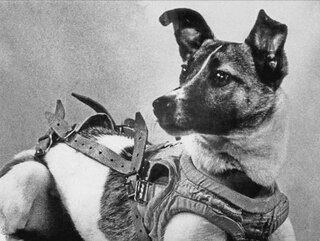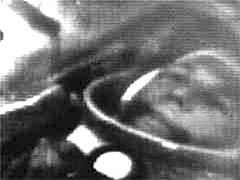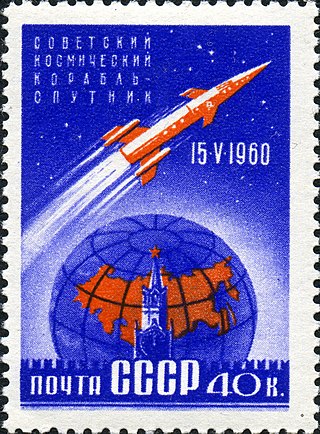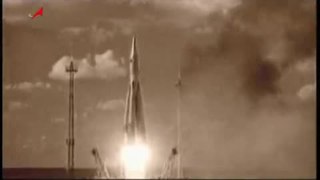
Laika was a Soviet space dog who was one of the first animals in space and the first to orbit the Earth. A stray mongrel from the streets of Moscow, she flew aboard the Sputnik 2 spacecraft, launched into low orbit on 3 November 1957. As the technology to de-orbit had not yet been developed, Laika's survival was never expected. She died of overheating hours into the flight, on the craft's fourth orbit.

Vostok 1 was the first spaceflight of the Vostok programme and the first human orbital spaceflight in history. The Vostok 3KA space capsule was launched from Baikonur Cosmodrome on 12 April 1961, with Soviet cosmonaut Yuri Gagarin aboard, making him the first human to reach orbital velocity around the Earth and to complete a full orbit around the Earth.
Tyazhely Sputnik, also known by its development name as Venera 1VA No. 1, and in the West as Sputnik 7, was a Soviet spacecraft, which was intended to be the first spacecraft to explore Venus. Due to a problem with its upper stage it failed to leave low Earth orbit. In order to avoid acknowledging the failure, the Soviet government instead announced that the entire spacecraft, including the upper stage, was a test of a "Heavy Satellite" which would serve as a launch platform for future missions. This resulted in the upper stage being considered a separate spacecraft, from which the probe was "launched", on several subsequent missions.

The Space Race was a 20th-century competition between two Cold War rivals, the United States and the Soviet Union, to achieve superior spaceflight capability. It had its origins in the ballistic missile-based nuclear arms race between the two nations following World War II and had its peak with the more particular Moon Race to land on the Moon between the US moonshot and Soviet moonshot programs. The technological advantage demonstrated by spaceflight achievement was seen as necessary for national security and became part of the symbolism and ideology of the time. The Space Race brought pioneering launches of artificial satellites, robotic space probes to the Moon, Venus, and Mars, and human spaceflight in low Earth orbit and ultimately to the Moon.

Zond 5 was a spacecraft of the Soviet Zond program. In September 1968 it became the first spaceship to travel to and circle the Moon in a circumlunar trajectory, the first Moon mission to include animals, and the first to return safely to Earth. Zond 5 carried the first terrestrial organisms to the vicinity of the Moon, including two tortoises, fruit fly eggs, and plants. The Russian tortoises underwent biological changes during the flight, but it was concluded that the changes were primarily due to starvation and that they were little affected by space travel.

Soyuz 7K-T No.39 was an unsuccessful launch of a crewed Soyuz spacecraft by the Soviet Union in 1975. The mission was expected to dock with the orbiting Salyut 4 space station, but due to a failure of the Soyuz launch vehicle the crew failed to make orbit. The crew consisted of commander Vasily Lazarev, and flight engineer Oleg Makarov, a civilian. Although the mission was aborted and did not accomplish its objective, the craft exceeded common space boundaries and therefore is recognized as a sub-orbital spaceflight, which the crew survived. The crew, who initially feared they had landed in China, were successfully recovered.

Vostok 2 was a Soviet space mission which carried cosmonaut Gherman Titov into orbit for a full day on August 6, 1961, to study the effects of a more prolonged period of weightlessness on the human body. Titov orbited the Earth over 17 times, exceeding the single orbit of Yuri Gagarin on Vostok 1 − as well as the suborbital spaceflights of American astronauts Alan Shepard and Gus Grissom aboard their respective Mercury-Redstone 3 and 4 missions. Titov's number of orbits and flight time would not be surpassed by an American astronaut until Gordon Cooper's Mercury-Atlas 9 spaceflight in May 1963.

Salyut 3 was a Soviet space station launched on 25 June 1974. It was the second Almaz military space station, and the first such station to be launched successfully. It was included in the Salyut program to disguise its true military nature. Due to the military nature of the station, the Soviet Union was reluctant to release information about its design, and about the missions relating to the station.

Korabl-Sputnik 2, also known as Sputnik 5 in the West, was a Soviet artificial satellite, and the third test flight of the Vostok spacecraft. It was the first spaceflight to send animals into orbit and return them safely back to Earth, including two Soviet space dogs, Belka and Strelka. Launched on 19 August 1960, it paved the way for the first human orbital flight, Vostok 1, which was launched less than eight months later.

Vostok was a class of single-pilot crewed spacecraft built by the Soviet Union. The first human spaceflight was accomplished with Vostok 1 on April 12, 1961, by Soviet cosmonaut Yuri Gagarin.

Korabl-Sputnik 1, also known as Sputnik 4 in the West, was the first test flight of the Soviet Vostok programme, and the first Vostok spacecraft. It was launched on May 15, 1960. Though Korabl-Sputnik 1 was uncrewed, it was a precursor to the first human spaceflight, Vostok 1. Its mass was 4,540 kilograms (10,010 lb), of which 1,477 kilograms (3,256 lb) was instrumentation.

The Vostok programme was a Soviet human spaceflight project to put the first Soviet cosmonauts into low Earth orbit and return them safely. Competing with the United States Project Mercury, it succeeded in placing the first human into space, Yuri Gagarin, in a single orbit in Vostok 1 on April 12, 1961. The Vostok capsule was developed from the Zenit spy satellite project, and its launch vehicle was adapted from the existing R-7 Semyorka intercontinental ballistic missile (ICBM) design. The name "Vostok" was treated as classified information until Gagarin's flight was first publicly disclosed to the world press.

The Soviet space program was the national space program of the Union of Soviet Socialist Republics (USSR), active from 1955 until the dissolution of the Soviet Union in 1991.

During the 1950s and 1960s the Soviet space program used dogs for sub-orbital and orbital space flights to determine whether human spaceflight was feasible. These dogs, including Laika, the first animal to orbit Earth, were surgically modified to provide the necessary information for human survival in space. The Soviet space program typically used female dogs due to their anatomical compatibility with the spacesuit. Similarly, they used mix-breed dogs due to their apparent hardiness.

Korabl-Sputnik 5 or Vostok-3KA No.2, also known as Sputnik 10 in the West, was a Soviet spacecraft which was launched in 1961, as part of the Vostok programme. It was the last test flight of the Vostok spacecraft design prior the first crewed flight, Vostok 1. It carried the mannequin Ivan Ivanovich, a dog named Zvezdochka, television cameras and scientific apparatus.

Ivan Ivanovich was the name given to a mannequin used in testing the Soviet Vostok spacecraft in preparation for its crewed missions.
The Lost Cosmonauts or Phantom Cosmonauts are subjects of a conspiracy theory, which alleges that Soviet and Russian space authorities have concealed the deaths of some cosmonauts in outer space. Proponents of the Lost Cosmonauts theory argue that the Soviet Union attempted to launch human spaceflights before Yuri Gagarin's first spaceflight, and that cosmonauts onboard died in those attempts. Soviet military pilot Vladimir Ilyushin was alleged to have landed off course and been held by the Chinese government. The Government of the Soviet Union supposedly suppressed this information, to prevent bad publicity during the height of the Cold War.

Spaceflight began in the 20th century following theoretical and practical breakthroughs by Konstantin Tsiolkovsky, Robert H. Goddard, and Hermann Oberth, each of whom published works proposing rockets as the means for spaceflight. The first successful large-scale rocket programs were initiated in Nazi Germany by Wernher von Braun. The Soviet Union took the lead in the post-war Space Race, launching the first satellite, the first animal, the first human and the first woman into orbit. The United States would then land the first men on the Moon in 1969. Through the late 20th century, France, the United Kingdom, Japan, and China were also working on projects to reach space.

Music in space is music played in or broadcast from a spacecraft in outer space. The first ever song that was performed in space was a Ukrainian song “Watching the sky...”(“Дивлюсь я на небо”) sang on 12 August 1962 by Pavlo Popovych, cosmonaut from Ukraine at a special request of Serhiy Korolyov, Soviet rocket engineer and spacecraft designer from Ukraine. According to the Smithsonian Institution, the first musical instruments played in outer space were an 8-note Hohner "Little Lady" harmonica and a handful of small bells carried by American astronauts Wally Schirra and Thomas P. Stafford aboard Gemini 6A. Upon achieving a space rendezvous in Earth orbit with their sister ship Gemini 7 in December 1965, Schirra and Stafford played a rendition of "Jingle Bells" over the radio after jokingly claiming to have seen an unidentified flying object piloted by Santa Claus. The instruments had been smuggled on-board without NASA's knowledge, leading Mission Control director Elliot See to exclaim "You're too much" to Schirra after the song. The harmonica was donated to the Smithsonian by Schirra in 1967, with his note that it "...plays quite well".















